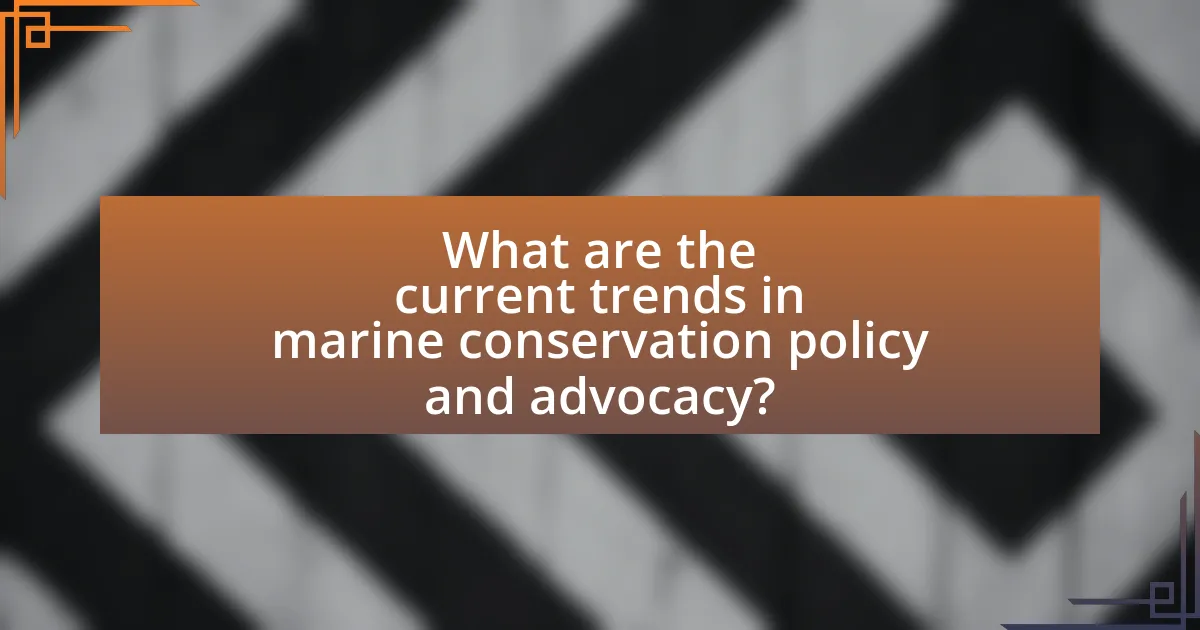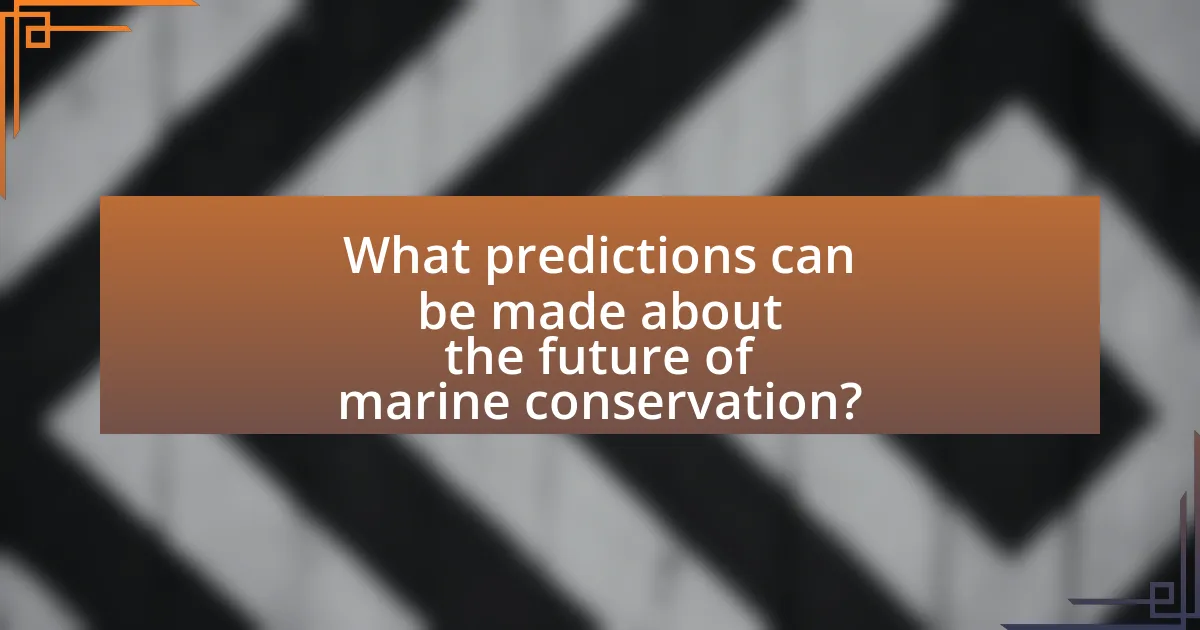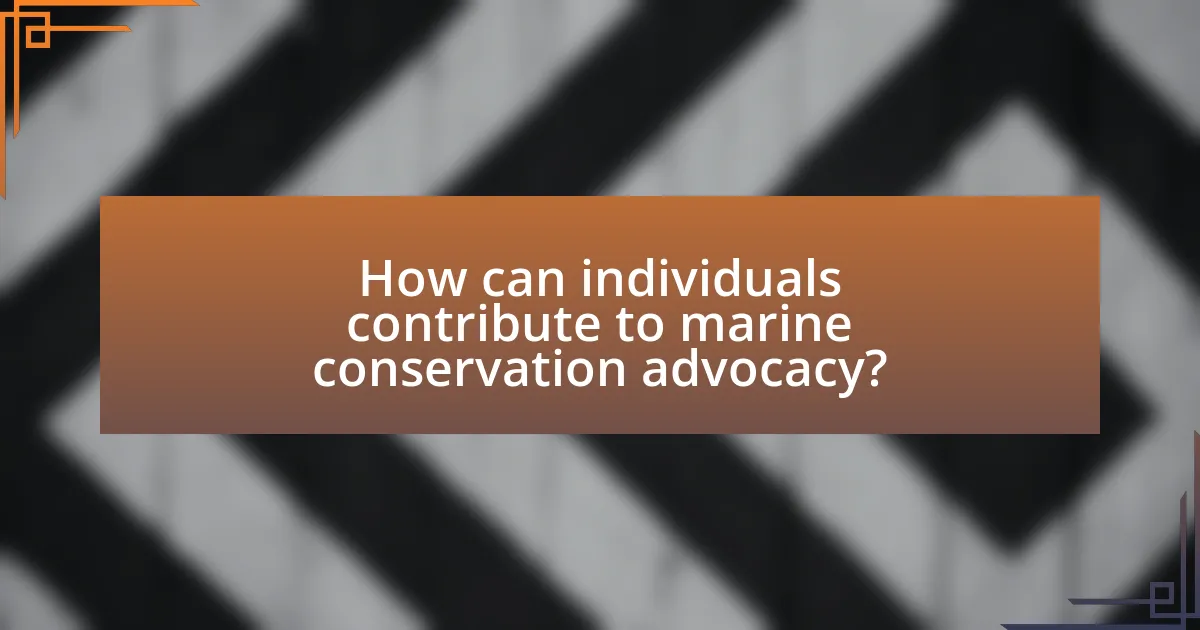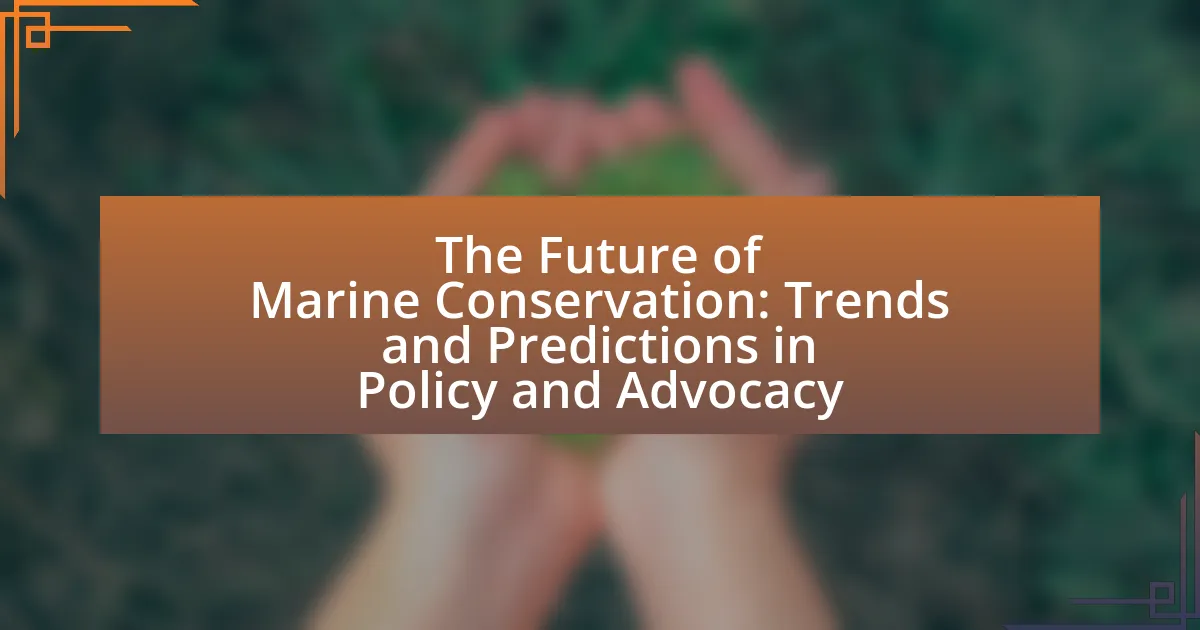The article focuses on the future of marine conservation, highlighting current trends and predictions in policy and advocacy. Key topics include the shift towards ecosystem-based management, the importance of international agreements like the United Nations Convention on the Law of the Sea, and the role of technology in enhancing monitoring and enforcement. It also examines the influence of advocacy groups and grassroots movements on policy changes, the anticipated challenges posed by climate change and socio-economic factors, and the strategies individuals can adopt to support marine conservation efforts. Overall, the article underscores the need for collaborative, science-based approaches to ensure the sustainability of marine ecosystems.

What are the current trends in marine conservation policy and advocacy?
Current trends in marine conservation policy and advocacy include a strong emphasis on ecosystem-based management, increased collaboration among stakeholders, and the integration of technology in monitoring and enforcement. Ecosystem-based management focuses on maintaining the health of marine ecosystems rather than managing individual species, which is supported by the United Nations’ Sustainable Development Goal 14 aimed at conserving oceans. Collaboration among governments, NGOs, and local communities is becoming essential, as seen in initiatives like the Global Ocean Alliance, which advocates for the protection of 30% of the world’s oceans by 2030. Additionally, the use of technology, such as satellite monitoring and artificial intelligence, is enhancing data collection and enforcement capabilities, thereby improving compliance with marine protection regulations. These trends reflect a shift towards more holistic and inclusive approaches in marine conservation efforts.
How are global policies evolving to address marine conservation?
Global policies are evolving to address marine conservation through the establishment of international agreements, increased funding for marine protected areas, and the integration of climate change considerations into marine management strategies. For instance, the United Nations’ Sustainable Development Goal 14 aims to conserve and sustainably use the oceans, seas, and marine resources, highlighting a global commitment to marine conservation. Additionally, the Convention on Biological Diversity has set targets for protecting at least 30% of the world’s oceans by 2030, reflecting a significant shift towards more ambitious conservation efforts. These developments indicate a growing recognition of the importance of marine ecosystems and the need for collaborative, science-based approaches to ensure their sustainability.
What international agreements are shaping marine conservation efforts?
The international agreements shaping marine conservation efforts include the United Nations Convention on the Law of the Sea (UNCLOS), the Convention on Biological Diversity (CBD), and the Paris Agreement. UNCLOS establishes a legal framework for the use and conservation of the world’s oceans, including the protection of marine biodiversity and the sustainable management of marine resources. The CBD aims to conserve biological diversity, promote sustainable use of its components, and ensure fair sharing of benefits arising from genetic resources, which directly impacts marine ecosystems. The Paris Agreement, while primarily focused on climate change, also addresses ocean health by recognizing the importance of marine ecosystems in mitigating climate impacts. These agreements collectively guide global policies and actions towards effective marine conservation.
How do national policies reflect global marine conservation trends?
National policies reflect global marine conservation trends by aligning local regulations with international agreements and frameworks aimed at protecting marine biodiversity. For instance, many countries have adopted policies that support the United Nations Sustainable Development Goal 14, which emphasizes the need to conserve and sustainably use the oceans, seas, and marine resources. This alignment is evident in the establishment of marine protected areas (MPAs) and the implementation of sustainable fishing practices, which are increasingly recognized as essential for maintaining healthy marine ecosystems. According to the World Database on Protected Areas, as of 2021, over 7% of the world’s oceans are designated as MPAs, showcasing a significant commitment from nations to adhere to global conservation efforts.
What role do advocacy groups play in marine conservation?
Advocacy groups play a crucial role in marine conservation by raising awareness, influencing policy, and mobilizing public support for marine protection initiatives. These organizations often conduct research and provide data that highlight the importance of marine ecosystems, such as the fact that oceans cover over 70% of the Earth’s surface and are vital for biodiversity and climate regulation. Additionally, advocacy groups engage in lobbying efforts to promote legislation aimed at protecting marine habitats, exemplified by the successful campaigns for the establishment of marine protected areas, which have increased by over 50% globally since 2010. Through education and outreach, these groups empower communities to participate in conservation efforts, thereby fostering a collective responsibility towards sustainable marine practices.
How do grassroots movements influence marine conservation policies?
Grassroots movements significantly influence marine conservation policies by mobilizing community support and raising awareness about environmental issues. These movements often engage local populations, fostering a sense of ownership and responsibility towards marine ecosystems, which can lead to increased public pressure on policymakers. For instance, the successful campaign by the grassroots organization Oceana has led to the implementation of sustainable fishing practices in various regions, demonstrating how community-driven advocacy can result in tangible policy changes. Additionally, grassroots movements often utilize social media platforms to amplify their message, reaching a broader audience and influencing public opinion, which can sway legislative decisions in favor of marine conservation.
What strategies are effective for marine conservation advocacy?
Effective strategies for marine conservation advocacy include community engagement, policy influence, and scientific communication. Community engagement fosters local stewardship and awareness, as seen in initiatives like the Coral Triangle Initiative, which mobilizes local communities to protect marine biodiversity. Policy influence involves lobbying for stronger regulations and protections, exemplified by the establishment of marine protected areas (MPAs) that have been shown to enhance fish populations and ecosystem health. Scientific communication is crucial for informing the public and policymakers about marine issues, as demonstrated by campaigns that utilize data from organizations like the Ocean Conservancy, which highlights the impact of plastic pollution on marine life. These strategies collectively enhance the effectiveness of marine conservation efforts.

What predictions can be made about the future of marine conservation?
Predictions about the future of marine conservation indicate an increased focus on integrated ocean management and enhanced policy frameworks. As global awareness of marine biodiversity loss grows, initiatives such as the United Nations Decade of Ocean Science for Sustainable Development (2021-2030) aim to promote scientific research and collaboration. Furthermore, the implementation of marine protected areas (MPAs) is expected to expand, with a target of protecting at least 30% of the ocean by 2030, as outlined in the Global Biodiversity Framework adopted at the COP15 summit. These trends suggest a shift towards more collaborative governance models that involve local communities and stakeholders in conservation efforts, thereby improving the effectiveness of marine policies.
How will technology impact marine conservation efforts?
Technology will significantly enhance marine conservation efforts by providing advanced tools for monitoring, data collection, and analysis. For instance, satellite imagery and drones enable real-time tracking of marine ecosystems, allowing for timely interventions in areas facing threats such as illegal fishing or habitat destruction. Additionally, artificial intelligence can analyze vast amounts of data to identify patterns and predict changes in marine biodiversity, facilitating more effective conservation strategies. According to a study published in the journal “Conservation Biology,” the integration of technology in marine conservation has led to a 30% increase in the effectiveness of management practices in protected areas. This demonstrates that technology not only aids in monitoring but also improves decision-making processes, ultimately contributing to the sustainability of marine environments.
What innovations are emerging in marine monitoring and protection?
Innovations in marine monitoring and protection include the use of autonomous underwater vehicles (AUVs), satellite remote sensing, and artificial intelligence (AI) for data analysis. AUVs enable detailed mapping and monitoring of marine ecosystems, allowing for real-time data collection on water quality and biodiversity. Satellite remote sensing provides extensive coverage of ocean conditions, helping to track changes in temperature, chlorophyll levels, and harmful algal blooms. AI enhances the analysis of large datasets, facilitating the identification of patterns and trends in marine life and environmental changes. These technologies collectively improve the effectiveness of conservation efforts and inform policy decisions, as evidenced by studies showing increased accuracy in monitoring marine protected areas through these advanced methods.
How can data analytics enhance marine conservation strategies?
Data analytics can enhance marine conservation strategies by providing actionable insights through the analysis of large datasets related to marine ecosystems. By utilizing data analytics, conservationists can identify patterns in species populations, track changes in habitat conditions, and assess the effectiveness of conservation measures. For instance, a study published in “Nature” by Halpern et al. (2015) demonstrated that data analytics could predict the impact of human activities on marine biodiversity, allowing for targeted interventions. Furthermore, real-time data collection from technologies like satellite imagery and underwater sensors enables timely decision-making, improving the responsiveness of conservation efforts. This evidence-based approach ensures that resources are allocated efficiently, maximizing the impact of marine conservation initiatives.
What are the anticipated challenges for marine conservation in the coming years?
Anticipated challenges for marine conservation in the coming years include climate change, overfishing, pollution, and habitat destruction. Climate change is expected to lead to ocean warming and acidification, which adversely affect marine ecosystems and species. Overfishing continues to deplete fish populations, threatening biodiversity and food security. Pollution, particularly plastic waste and chemical runoff, poses significant risks to marine life and habitats. Habitat destruction, driven by coastal development and industrial activities, further exacerbates the decline of marine environments. These challenges are supported by data indicating that approximately 30% of fish stocks are overfished, and marine pollution has increased by 10% annually over the past decade.
How will climate change affect marine ecosystems and conservation efforts?
Climate change will significantly disrupt marine ecosystems and hinder conservation efforts. Rising ocean temperatures lead to coral bleaching, which affects biodiversity and the health of marine habitats. For instance, the Great Barrier Reef has experienced severe bleaching events, with over 50% of its coral lost since 2016 due to elevated sea temperatures. Additionally, ocean acidification, a direct result of increased carbon dioxide levels, threatens shellfish and other marine organisms that rely on calcium carbonate for their shells, impacting food webs and fisheries. Conservation efforts are further challenged as shifting species distributions require adaptive management strategies, which are often underfunded and politically contentious. The Intergovernmental Panel on Climate Change (IPCC) reports that without significant mitigation efforts, marine biodiversity could decline by 30% by 2050, underscoring the urgent need for integrated climate and conservation policies.
What socio-economic factors could hinder marine conservation initiatives?
Socio-economic factors that could hinder marine conservation initiatives include poverty, lack of education, and economic dependency on marine resources. Poverty limits communities’ ability to invest in conservation efforts, as financial resources are often prioritized for immediate survival needs. Lack of education reduces awareness of the importance of marine ecosystems, leading to insufficient public support for conservation policies. Additionally, communities that rely heavily on fishing and tourism may resist conservation measures that threaten their livelihoods, creating conflicts between economic interests and environmental protection. For instance, a study by the World Bank highlights that over 1 billion people depend on fisheries for their primary source of protein and income, illustrating the challenge of balancing economic needs with conservation goals.

How can individuals contribute to marine conservation advocacy?
Individuals can contribute to marine conservation advocacy by participating in local clean-up events, supporting sustainable seafood initiatives, and engaging in policy advocacy. By joining community efforts to remove debris from beaches and waterways, individuals help reduce pollution and protect marine habitats. Supporting sustainable seafood initiatives encourages responsible fishing practices, which can lead to healthier fish populations and ecosystems. Engaging in policy advocacy, such as contacting legislators or participating in campaigns, empowers individuals to influence marine conservation policies. According to the National Oceanic and Atmospheric Administration, community involvement in conservation efforts has been shown to significantly enhance the effectiveness of marine protection initiatives.
What actions can individuals take to support marine conservation?
Individuals can support marine conservation by reducing plastic use, participating in beach clean-ups, and advocating for sustainable fishing practices. Reducing plastic use helps decrease ocean pollution, as an estimated 8 million tons of plastic enter the oceans annually, harming marine life. Participating in beach clean-ups directly removes debris that can entangle or be ingested by marine animals, contributing to healthier ecosystems. Advocating for sustainable fishing practices ensures that fish populations remain stable and ecosystems are preserved, as overfishing has led to the decline of numerous species.
How can community engagement enhance marine conservation efforts?
Community engagement enhances marine conservation efforts by fostering local stewardship and increasing awareness of marine issues. When communities actively participate in conservation initiatives, they develop a sense of ownership and responsibility towards their marine environments. Research indicates that local involvement can lead to more effective management practices, as seen in the case of community-managed marine protected areas, which have shown higher biodiversity and fish biomass compared to traditionally managed areas. Furthermore, studies demonstrate that engaged communities are more likely to support and adhere to conservation regulations, resulting in improved compliance and sustainability of marine resources.
What role does education play in promoting marine conservation awareness?
Education plays a crucial role in promoting marine conservation awareness by equipping individuals with knowledge about marine ecosystems and the threats they face. Through formal education programs, workshops, and community outreach, people learn about the importance of biodiversity, sustainable practices, and the impact of human activities on marine life. Research indicates that educational initiatives, such as the Ocean Literacy Framework, enhance public understanding and foster a sense of stewardship towards marine environments. This increased awareness can lead to more informed decision-making and advocacy for policies that protect marine resources, ultimately contributing to the sustainability of ocean ecosystems.
What best practices should individuals follow in marine conservation advocacy?
Individuals should engage in informed advocacy, which involves educating themselves about marine ecosystems, threats, and conservation strategies. This knowledge enables effective communication and persuasion when discussing marine issues with others. Additionally, individuals should participate in local conservation initiatives, such as beach clean-ups or habitat restoration projects, which demonstrate commitment and foster community involvement. Collaborating with established organizations enhances credibility and amplifies impact, as these groups often have resources and networks that individuals can leverage. Furthermore, advocating for policy changes through petitions, public comments, and direct communication with policymakers is crucial, as evidenced by the success of grassroots movements in influencing marine legislation. Lastly, utilizing social media platforms to raise awareness and share information can significantly broaden outreach and mobilize support for marine conservation efforts.
How can effective communication strategies improve advocacy outcomes?
Effective communication strategies can significantly enhance advocacy outcomes by ensuring that messages resonate with target audiences and mobilize support. Clear, concise messaging tailored to the audience’s values and concerns fosters understanding and engagement, which is crucial in advocacy efforts. For instance, research by the FrameWorks Institute highlights that effective framing of issues can lead to increased public support for marine conservation initiatives, demonstrating that how information is presented can influence perceptions and actions. Furthermore, utilizing multiple communication channels, such as social media, traditional media, and community outreach, amplifies the reach and impact of advocacy messages, thereby increasing the likelihood of achieving desired policy changes.
What resources are available for individuals interested in marine conservation?
Individuals interested in marine conservation can access a variety of resources, including educational programs, online courses, and volunteer opportunities. Organizations such as the Ocean Conservancy and the Marine Conservation Society offer educational materials and training programs that focus on marine ecosystems and conservation strategies. Additionally, platforms like Coursera and edX provide online courses on marine biology and conservation, often created by reputable universities. Volunteer programs, such as those offered by Sea Shepherd and local marine sanctuaries, allow individuals to participate in hands-on conservation efforts, contributing to real-world projects while gaining practical experience. These resources collectively empower individuals to engage actively in marine conservation efforts.
